The secret police: After protests around George Floyd’s murder ended, a police system for watching protesters kept going
Despite public assertions that it had gone dormant, a multi-agency task force consisting of federal, state, and local police that was created to monitor protests in Minnesota during the murder trial of former police officer Derek Chauvin continued to operate in secret after the trial’s conclusion, according to emails and documents examined by MIT Technology Review. The program, known as Operation Safety Net (OSN), held regular meetings, conducted policing operations, continued close coordination, and updated intelligence documents until at least October 2021, far past its publicly announced “demobilization” in April 2021.
OSN was created to provide security during Chauvin’s trial, but quickly expanded beyond its announced scope. When an officer from nearby Brooklyn Center, Minnesota, shot and killed Daunte Wright just a few days before the Chauvin verdict, OSN descended upon the protests that erupted in the Minneapolis suburb. It continued to operate there and throughout the region throughout 2021. Although OSN is based in Minnesota, it has far-reaching implications as to the ways technology can be leveraged to de-anonymize protestors, track journalists, and monitor activists.
Our investigation shows that the joint command structure spanning 11 state, local, and federal agencies oversaw an immensely powerful surveillance machine, rendering anonymous protest—which the US Supreme Court has upheld as a core tenant of free speech—much more difficult. Furthermore, when asked about whether OSN was ongoing, both internal communications and statements made to MIT Technology Review asserted that the operation “did not exist” despite evidence that it did.
A string of contradictions
Public statements from officials during press conferences and local news reports created the impression that OSN went into a dormant phase the same week as Derek Chauvin’s guilty verdict, though the door was left open to renewing the effort later. On April 22, OSN tweeted “Update: We are in Phase four of OSN. This includes scaling back on resources with the ability to quickly increase them if needed.” The group has not posted on social media or held a press conference since that time.
Officials said that the operation would shut down in late April 2021, with the exception of some planning meetings for future trials. However, emails from July 2021 through November 2021 obtained through a public records request to the City of Minneapolis show that OSN remained active and, without public acknowledgement, issued directives on how to handle protests that had nothing to do with the murder of George Floyd or the trials of the officers involved. In October 2021, the Minneapolis Police Department responded to protests in the city’s Uptown neighborhood following the killing of Winston Smith by law enforcement officers. Internal planning documents titled “Operations Plan/Operation Safety Net” explained how officers should go about making arrests, how to book protesters, assigned roles, and laid out other procedures.
Among those procedures, the documents confirmed what protesters had alleged was a new tactic—arresting demonstrators, refusing to say under what charges, and either dropping them off blocks away or booking them in jail. “The MPD booking team will NOT take an arrestee without a confirmed arresting officer,” the document reads, “who shall later provide a supplement covering the [probable cause] for the arrest.” The plan notes that intelligence will be provided as needed by the MPD Strategic Information Center, a real-time crime center that was essential to OSN.
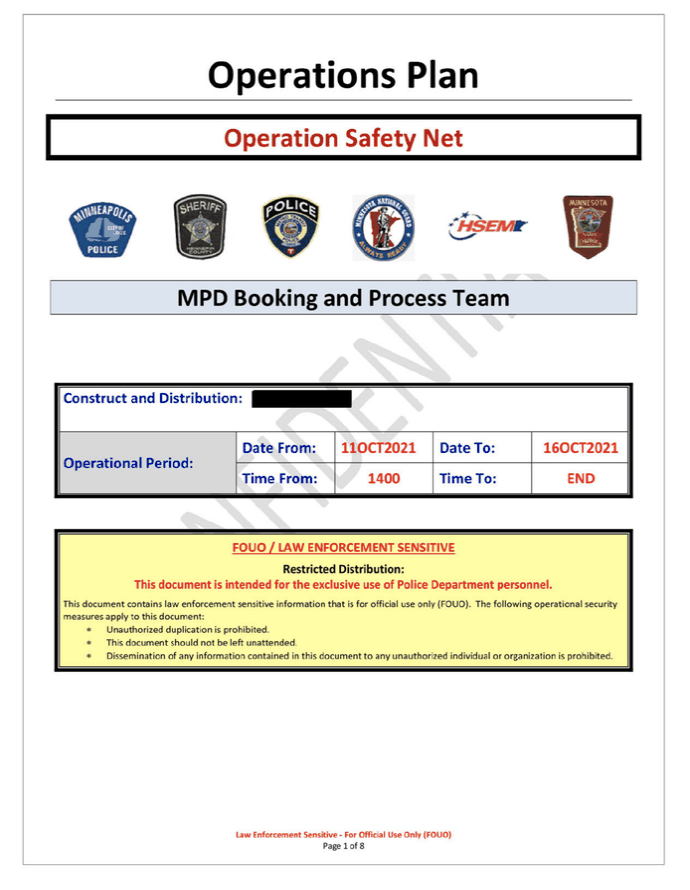
In an email to MIT Technology Review, the Minneapolis Police Department replied “OSN was a planned response to the Chauvin trial. When that trial ended, the operation specific to OSN ended.” Additionally, the department indicated that a joint response between law enforcement agencies is common. “Work continues within an everyday framework that supports mutual aid among agencies.”
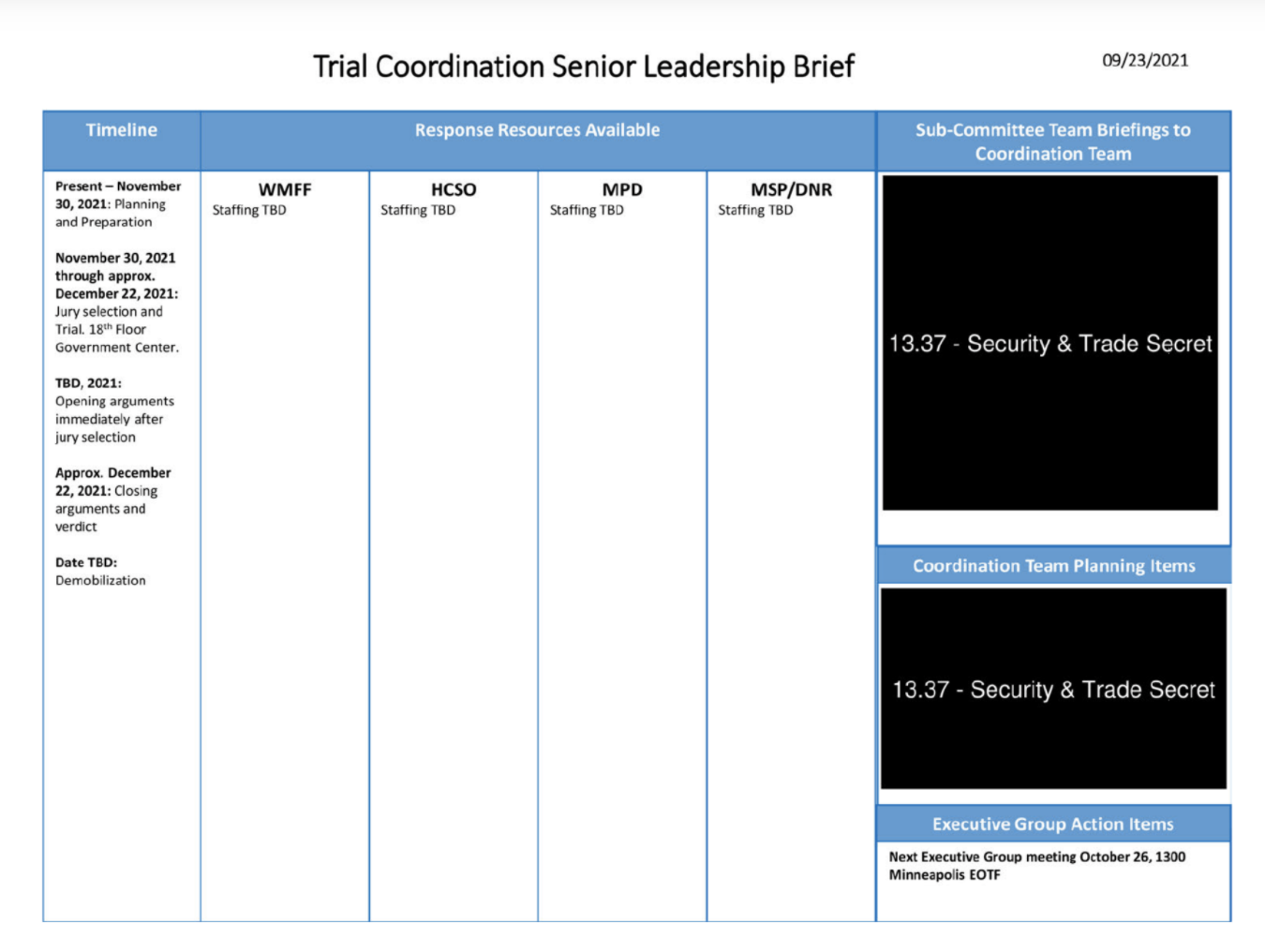
In one senior leadership brief regarding “trial coordination” dated September 23, 2021, the timeline for demobilization says “date TBD.” This conflicts with statements delivered to the press on behalf of OSN which suggested the operation was demobilized last April.
In an email to MIT Technology Review dated October 25, 2021, Doug Neville, a spokesperson for OSN and the deputy director of communications at the Department of Public Safety, said “it’s not an ongoing operation.” An internal email also sent by Neville in October 2021 states “OSN no longer exists.”
That again conflicts with what documents show. Elements of OSN designated the “executive,” “intelligence,” and “communications” teams were meeting regularly. Purchase orders for police equipment also continued. In one email exchange, a sergeant from the Minneapolis Police Department requested three redacted items prior to the Chauvin trial from Grainger, an industrial supply retail store, for SWAT operations. According to email exchanges, the supplies were not delivered as of last summer, but in August, the officer asked that they be delivered because “SWAT still needs it for the next set of trials.”
To support MIT Technology Review’s journalism, please consider becoming a subscriber.
OSN team activities
The activities of each of the OSN teams mentioned is unclear—the agencies involved in OSN responded to our request for clarification by saying that “mutual aid” and “joint response” was commonplace, and that a collaborative response to trials for officers outside of the George Floyd murder did occur. “As with any event that could span across multiple agencies or government entities, affected groups met to discuss how collaboration could best occur to ensure public safety,” the Minneapolis Police Department said in an email. “These relationships and efforts continue. OSN is no longer operational.”
However, multiple email chains we examined dated in October included meetings of “OSN Communications,” “OSN Executive Team” and the “OSN Intel Team” related to preparations for protests that may arise around the trial of Kim Potter, the officer who killed Daunte Wright, as well as trials for the three officers other than Chauvin who were charged with crimes in connection with George Floyd’s murder. (Potter was found guilty of manslaughter and sentenced last month; the three officers involved in Floyd’s murder were convicted in federal court last month and are awaiting sentencing.) In one executive team meeting email, the agenda refers to the ongoing plans as “OSN 2.0.” Bruce Gordon, a spokesperson from the state Department of Public Safety, says any such reference was “informal,” and that “there never has been, nor is there now, an OSN 2.0.”
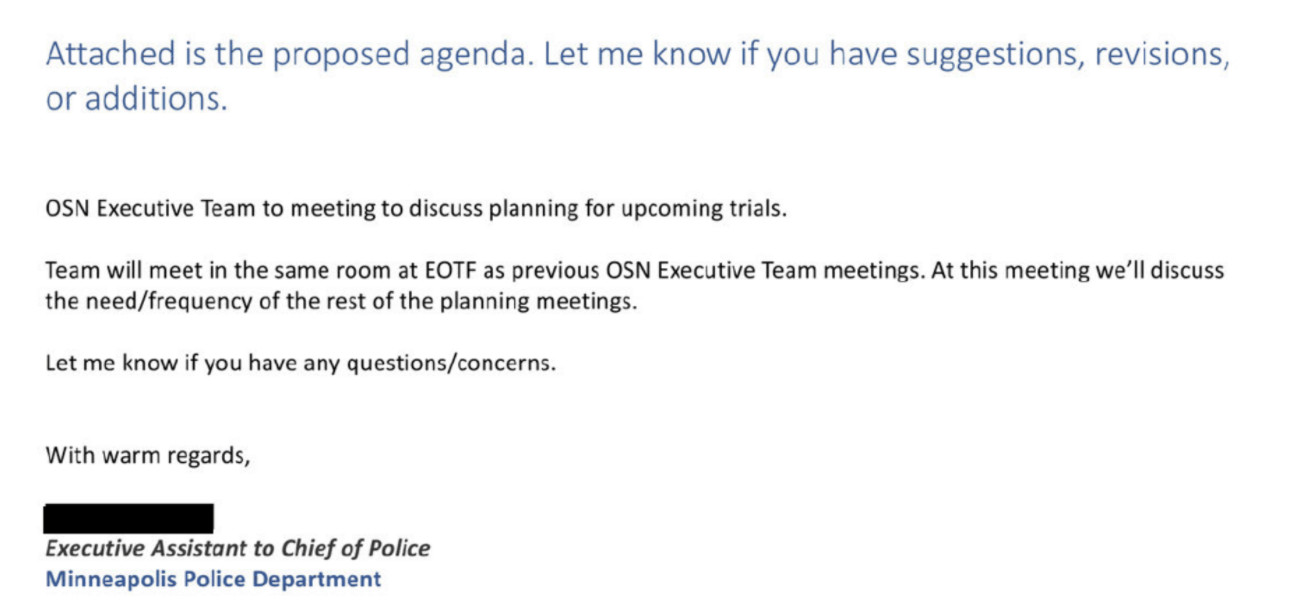
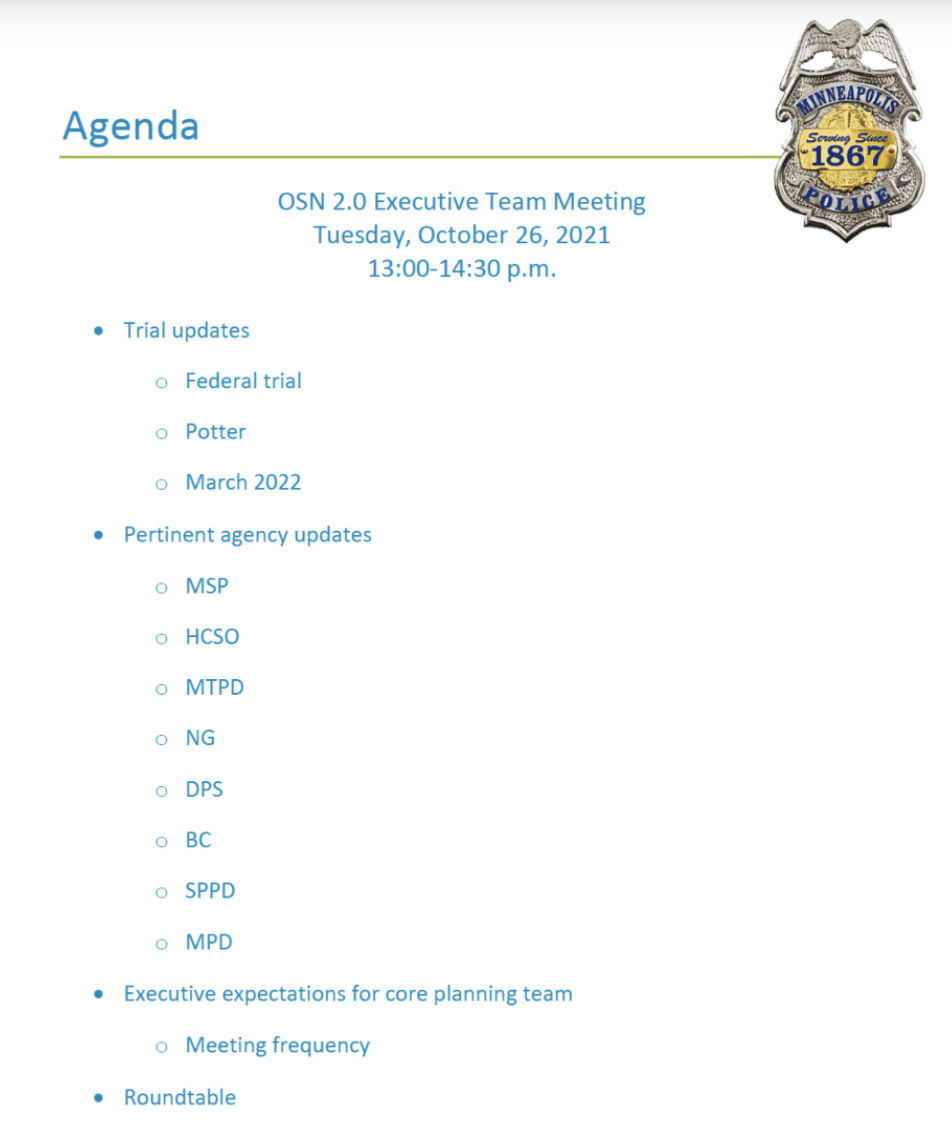
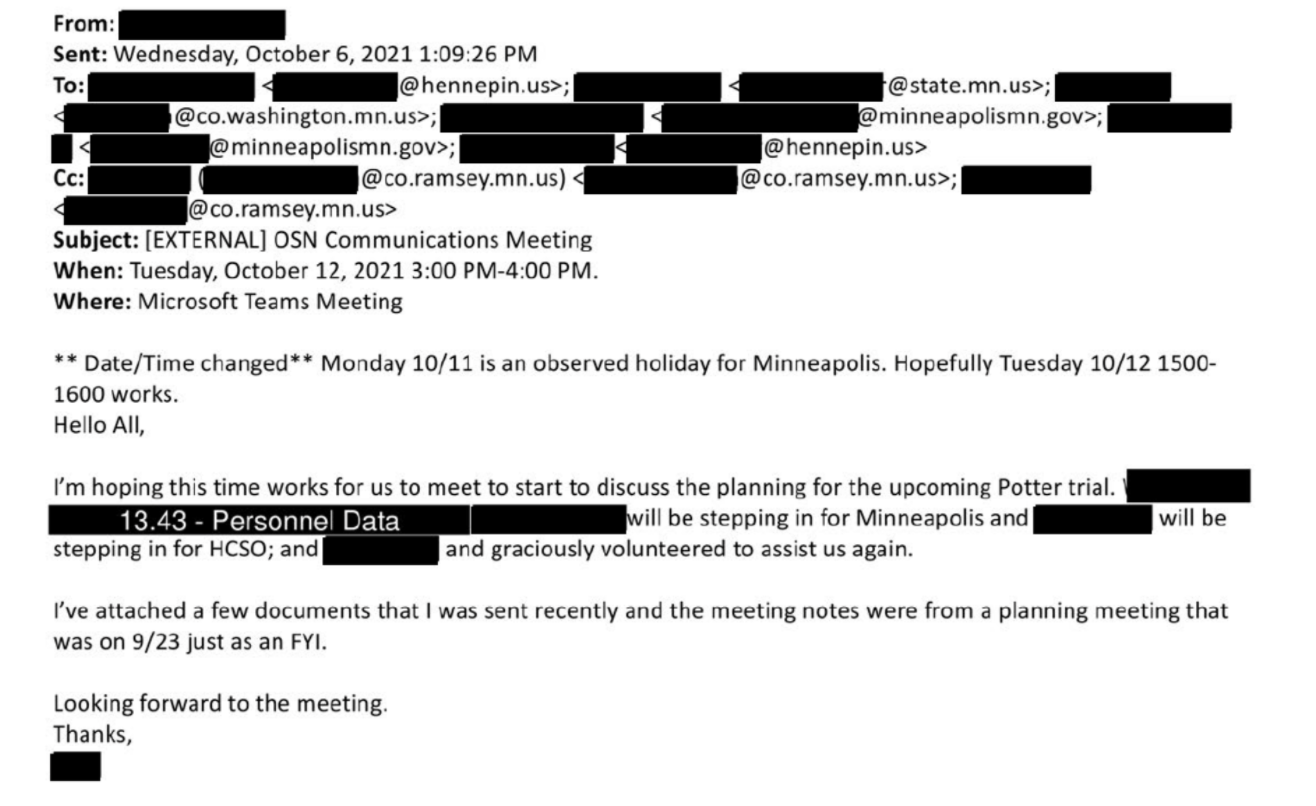
On the intelligence team, shared files used to pass information between law enforcement agencies continued to be added to and updated as of last October, which is the latest period covered by our records requests. The group was holding regular meetings, according to emails consisting of 12 people, including two from the FBI. In a response to a request for comment from MIT Technology Review, Cynthia Barrington, a public affairs officer with the FBI, said that the bureau’s activities extended to sharing information “through state and regional fusion centers.” Barrington also acknowledged the bureau’s involvement in preparations for protests stemming from other trials other than Chauvin’s. “This was the case during the run up to the state trial involving former Minneapolis Police Officer Derek Chauvin, as well as during preparations preceding subsequent court activities surrounding recent highly publicized state and federal prosecutions.”
“The ‘Intel Team’ by name is an email group of local, state, and federal agencies with law enforcement responsibilities during OSN,” Gordon says. “These agencies are involved with other event planning, and the same group email may have been used in other, unrelated planning efforts. All agencies involved have ongoing responsibilities related to public safety that did not end when OSN ended.”


Munira Mohamed, a policy associate at the ACLU of Minnesota, said that the “porous nature” of collaborative law enforcement practices creates “all these opportunities for loopholes and to evade public scrutiny and public oversight.” Mohamed said the ongoing nature of OSN activities is a “tale of mission creep” and that “the history of surveillance and these law enforcement agencies is that once the infrastructure for something is set up, it kind of goes on unabated, it continues, and it becomes a permanent infrastructure.”
Although it is unclear to what extent the program’s ongoing nature is formal, many of the teams, operations, and communication structures put in place for OSN remain in effect to this day and are used to respond to protest activity. A spokesperson for the Minneapolis Police Department told MIT Technology Review in an email that the agency had “returned to normal operations at the conclusion of OSN effective Friday, April 23rd.” Hennepin County Sheriff’s Department has declined our requests for comment.
